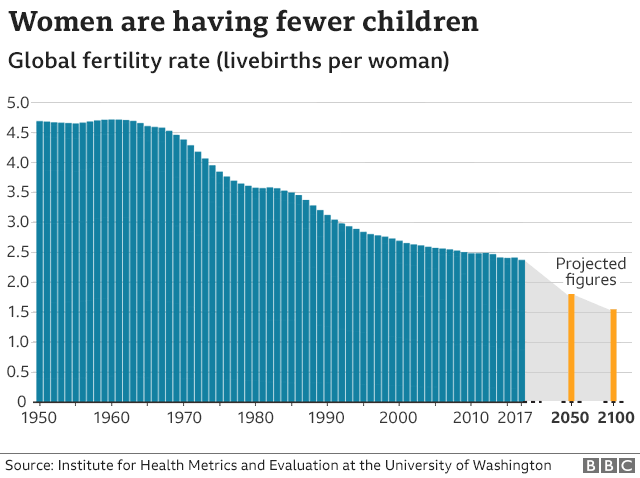Lahore, 15th July: According to researchers, the world is ill-prepared for the global crash in the fertility rate which will have a ‘jaw-dropping’ effect on societies all across.
Falling fertility rates means that almost every country will most likely have shrinking populations by the end of the century. Around 23 nations, including Japan and Spain, are expected to see their populations halve by 2100.
Consequently, countries will also age dramatically, as there will be an equal number of people turning 80 as are being born.
Remembering Qandeel Baloch on her death anniversary
What is Happening?
The fertility rate, which is defined as the average number of children a woman gives birth to, is falling. If this number falls below 2.1, then the size of the population decreases.
Researchers at the University of Washington’s Institute for Health Metrics and Evaluation found that global fertility rate nearly halved to 2.4 in 2017, their study published in The Lancet predicts that this figure will further fall to 1.7 by 2100.
Sara Khan shares a good news with her fans

The researchers expect that the number of people on the planet will peak at 9.7 billion around 2064, then start to fall down to 8.8 billion by the end of the century.
FAA revises international safety rating for Pakistan
Researcher Prof Christopher Murray told the BBC ‘That’s a pretty big thing; most of the world is transitioning into natural population decline.’ He further continued saying ‘I think it’s incredibly hard to think this through and recognize how big a thing this is; it’s extraordinary, we’ll have to reorganize societies.’
Why are Fertility Rates Falling?
This is not related to sperm counts or the other usual things related to the topic of fertility. Rather it is influenced by more women deciding to pursue their education and career, as well as there is more access to contraception, leading to fewer children.
In more than one way, falling fertility rates are a success story.
Which Countries Will Be Most Affected?
Japan’s Population is expected to see a dramatic decrease from a peak of 128 million in 2017 to less than 53 million by the end of the century.
Likewise, Italy is projected to see a major dip in its population from 61 million to 28 million over the same time frame.
Karachi-born Scientist to become the vice president at Max Plank Society
23 other countries are expected to see half of their population decrease, these include Spain, Portugal, Thailand, and South Korea.
Prof. Christopher Murray commented that ‘That is jaw-dropping.’
China, which is currently the most populous country today, is expected to peak at 1.4 billion within four years’ time before nearly halving to 732 million by 2100. India will then take its place.
Even the UK is expected to initially peak at 75 million in 2063 and then fall to 71 million by 2100.

However, this will be a global issue, where 183 out of 195 countries will have a fertility rate below the replacement level.
Ali Zaidi demands Bilawal Zardari to show Benazir Bhutto’s will
Why Is This a Problem?
This might be beneficial to the environment as it would result in lower carbon emissions as well as deforestation for farmland.
Prof Murray shares ‘That would be true except for the inverted age structure (more old people than young people) and all the uniformly negative consequences of an inverted age structure.’
The study predicts that:
- The number of under-fives will decrease from 681 million in 2017 to 401 million in 2100.
- The number of over 80-year-olds will increase from 141 million in 2017 to 866 million in 2100.
Professor Murray further says that ‘It will create enormous social change. It makes me worried because I have an eight-year-old daughter and I wonder what the world will be like.’
Chief Minister Punjab Usman Buzdar likely to be removed: Sources
Who will pay taxes in a world full of older people? Who will pay for their healthcare? Who will look after them? Will people be able to retire?
Prof Murray says that ‘We need a soft landing.’
Are There Any Solutions?
Some countries, like the UK, have used migration to boost their population and counter decreasing fertility rates. However, this will prove to be ineffective once every country sees a decrease in its population.
Prof Murray argues that ‘We will go from the period where it’s a choice to open borders, or not, to frank competition for migrants, as there won’t be enough.’
Trump admits he’s behind UK Huawei ban for 5G services
Certain countries have tried policies such as enhanced maternity and paternity leave, free childcare, financial incentives, and extra employment rights, but there is no clear answer.
Sweden has boosted its fertility rate from 1.7 to 1.9. However, other countries tackling this crisis have not been as successful. Such as Singapore, which still has a fertility rate of 1.3.
Prof Murray comments ‘I find people laugh it off; they can’t imagine it could be true, they think women will just decide to have more kids. If you can’t [find a solution] then eventually the species disappears, but that’s a few centuries away.”
Donald Trump shows interest in buying Roosevelt Hotel
The researchers have given out warnings against undoing the progress on women’s education and access to contraception.
Prof Stein Emil Vollset says ‘Responding to population decline is likely to become an overriding policy concern in many nations, but must not compromise efforts to enhance women’s reproductive health or progress on women’s rights.’
Stay tuned to Baaghi TV for more news and updates!






